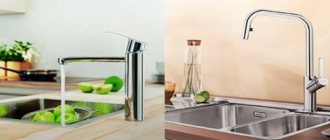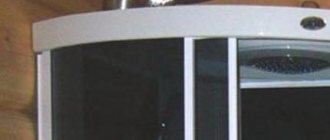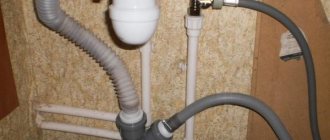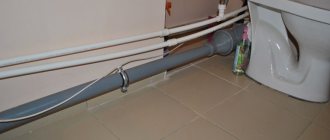If you need to connect a toilet to a sewer system, the question arises: can this be done independently? You don’t need to be a plumber or have special skills for this, so after familiarizing yourself with the rules and features of installation, you can start working. Later in the article we will talk about connecting a toilet to a sewer with corrugation and about installation without it. We will tell you what diameter of pipe should be used to connect the toilet to the sewer riser. We will also consider the details of installing a toilet with oblique and straight outlets.
Standard sizes of different types of toilets
All toilets are divided into the following types:
- floor;
- hanging;
- children's;
- corner.
Parameters of floor-standing toilets
Floor-standing toilets can be:
with a solid shelf on which the flush cistern is installed (compact toilet);
Plumbing product with a shelf for installing a tank
without shelf. In this situation, the tank can be attached to the wall or built into the wall.
Plumbing product with separate cistern
Russian manufacturers produce floor-standing toilets in accordance with GOST:
- standard compact toilet sizes:
- length of plumbing – 610 mm – 645 mm;
- bowl width – from 345 mm;
- height – from 370 mm to 395 mm;
- The dimensions of a toilet without a shelf are respectively:
- product length – from 435 mm – to 460 mm;
- width of plumbing – 360 mm;
- toilet height from the floor – 355 mm – 390 mm.
Dimensions of floor-standing toilets of different types
The standard dimensions of a foreign-made toilet are slightly larger than domestic ones and are:
- length – up to 685 mm;
- width – up to 365 mm;
- height – up to 410 mm.
Dimensions of foreign-made plumbing fixtures
Large toilets, suitable for use by large people or people with disabilities, are produced exclusively on special order.
Dimensions of wall-hung toilets
Recently, wall-hung toilets have become very popular, allowing you to save space and comfortably clean the toilet room.
The belief of many people that hanging plumbing products are designed exclusively for “fragile” people is false. A standard toilet can withstand a load of up to 400 kg.
The sizes of wall-hung toilets produced by various manufacturers vary within the following limits:
- length – 480 mm – 700 mm;
- width - 355 mm - 375 mm;
- height – up to 395 mm.
Standard dimensions of wall-hung sanitary ware
As mentioned earlier, when choosing the size of a wall-hung toilet, it is necessary to take into account the dimensions of the fastening elements and the connection points with the sewer pipe.
Most installations allow you to adjust the installation height of the plumbing fixture yourself.
Toilet sizes for children
For small family members, it is more advisable to install a children's toilet, which increases safety and comfort during use.
Various manufacturers have been producing specialized plumbing fixtures for children for a long time, which differ from adult plumbing fixtures only in their overall dimensions.
Children's toilets have the following parameters:
- bowl width – 290 mm – 320 mm;
- seat height – 260 mm – 350 mm;
- seat length – 460 mm – 550 mm.
Dimensional parameters of the toilet for small users
When choosing a children's toilet, it is important to consider the height and weight of the small user. Please note that children grow quite quickly
Experts recommend making a margin of 20% on the parameters so as not to change the plumbing fixture too often.
Children's toilets take up a certain place. Installing a separate plumbing fixture is advisable if there is enough free space in the toilet room and additional equipment will not cause constraint. Otherwise, for your child, you can purchase special covers for a standard toilet, which also provide maximum comfort.
Overall dimensions of corner toilets
A type of floor-standing toilets are specialized plumbing devices that are installed in the corner of the bathroom or toilet room. Corner toilets save space and are most often used in combined bathrooms.
Floor-standing toilet installed in the corner of the room
The parameters of the corner toilet (length and width) are selected depending on the corresponding dimensions of the corner and the plumbing equipment installed nearby. All the above standards also apply to corner plumbing fixtures.
The following sizes are considered standard:
- width of the sanitary ware – 345 mm – 375 mm;
- toilet length – 720 mm – 790 mm.
What is the height of a toilet installed in a corner? This parameter is determined by the standards for floor-standing toilets and can vary between 350 mm - 400 mm.
Basic parameters of corner plumbing
When selecting the parameters of a corner toilet, it is also necessary to take into account the overall dimensions of the cistern.
After selecting the size of the toilet, it is recommended to select the size of additional devices: cistern, seat cover, installation, and so on. Only by combining the toilet and all additional components will the use of the plumbing fixture be as comfortable as possible for all family members.
Device and classification
Shape of the outlet pipe of the drainage system
The following types of pipes are distinguished:
- Oblique (angular) or “outlet into the wall”
- Straight or horizontal
- Vertical or “floor outlet”
Type (shape) of the bowl
The standard is considered to be plumbing fixtures with a funnel-shaped, visor-shaped and dish-shaped bowl (see figure). The plate version can be considered obsolete despite its infrequent, but still presence in construction stores.
Funnel-shaped and visor have their own pros and cons. One form is good for everyone, but it splashes a lot, the other has almost no splashes, but more often a brush is required and the noise level is higher when draining water.
Flush cistern
Sanitaryware is also divided according to the installation method. Classics of the genre are floor-mounted and wall-hung toilets, which can be found in both corner and wall-mounted versions. It’s quite easy to get confused in such a variety, so let’s look at the standard sizes that you can use when choosing plumbing fixtures.
Do you know?
That the word “toilet” appeared quite recently. The Spanish company Unitas launched mass production of plumbing products made of earthenware 1909 Later, the word toilet began to be used to refer to any sanitary and technical device, regardless of the manufacturer.
Minimum dimensions of a bathroom in an apartment and private house
November 7, 2016
What is a "bathroom"? The bathroom is a central and very important part of any home or apartment. This term should be understood as a restroom, in which there is at least a toilet and a washbasin. When space allows, then a urinal and bidet are added. There are also bathrooms with at least a bathtub and possibly a shower. You should also take into account combined bathrooms - rooms in which plumbing fixtures for the bathroom and toilet are installed. Such combined bathrooms are often designed to save space and, of course, for the convenience of residents. The size of these premises depends on the category of housing.
According to building codes and regulations, the designed housing is divided into categories, taking into account the level of comfort and social orientation: I and II. The requirements of these standards apply to both categories and take into account the sanitary and hygienic well-being of residents of these categories of housing. For example, in one-room apartments it is planned to have a combined bathroom (toilet, bathtub, washbasin). Two- and three-room apartments of each category have separate bathrooms (toilet with toilet and washbasin, bathroom with washbasin). In four or more room apartments, at least two combined bathrooms are expected, each of them must have a toilet. But now we’ll talk about the minimum dimensions of a bathroom and how to use them to your advantage.
Organization of the transition from cast iron pipes to plastic
Cast iron sewer pipes, which serve as outlets for sanitary fixtures, have the following diameters: toilet - 123 mm, bathtub and kitchen sink - 73 mm. At the same time, plastic pipes used as elements of the sewerage system are smaller in size (110 and 50 mm).
In this regard, situations arise when it is necessary to connect a plastic pipe to a cast iron riser with a large diameter. To put this into practice, they purchase a special rubber cuff, which is mounted in the sewer socket.
Preparing a cast iron pipe
To prepare the old pipe, you will need to clean its socket from the cement mortar previously used to make this connection airtight. This can be done using a hammer, pry bar and screwdriver.
The cement mortar must be removed by freeing the joint, which is achieved with a screwdriver and a hammer, that is, by tapping the second on the first, you should get rid of the cement layer. Then you will need to insert a wooden stick into the pipe.
As for rust and various types of deposits, they can be easily removed using such a simple device as a metal brush mounted on an electric drill. If there are too problematic places that cannot be affected by a kind of electric brush, then you will have to use a screwdriver and a chisel.
In order to achieve greater efficiency when cleaning the inner surface of the bell, you can use special substances that will corrode existing contaminants. Finally, at the last stage, you need to take a clean rag and wipe the walls of the bell.
The connection of pipes made of different materials, in our case it is cast iron and plastic, will be more reliable if it is possible to clean the walls of the socket as thoroughly as possible, giving them a certain smoothness.
Cuff installation
In order for the sealing of the cuff in the socket of the sewer pipe to be sufficiently tight, you should use a sealant that must be applied to the walls. To ensure a tighter connection of the contacting walls of two products made of different materials, it is advisable not to tap too hard with a hammer on the edge of the cuff, but to apply plumbing grease inside it, which is necessary to simplify the installation process in the socket of a plastic tee. If this does not help during installation, then you should take a hammer and knock on the plywood that was previously attached to the pipe.
At the last step, the corrugation is connected to a plastic tee, which is the final stage of connecting the toilet.
What are the standard sizes of bathrooms and the minimum according to snip
Size, whatever one may say, matters... especially when it comes to what the size of the bathroom should be. The legislation of all countries has clear standards regulating the area of the bathroom and toilet.
In this article we will tell you what standard bathroom sizes exist, discuss the minimum possible dimensions, and tell you how to correctly determine the area of the sanitary room in your future home.
Dimensions – SNiP and DIN
The current technical regulations, reflected in SNiP and DIN 18022, clearly define the dimensions of a bathroom for residential premises:
- minimum floor/ceiling height – 2500 mm;
- depth – not less than 1200 mm;
- in the attic, the distance from the toilet to the roof slope is 1050 mm;
- The minimum width of the bathroom is 800 mm.
Important: Doors must open exclusively outward, and exit only to the hallway and corridor, to living rooms and to the kitchen; exit from the bathroom and toilet is prohibited. The height of the ceilings in the corridor at the exit should not be less than 2100 mm.
SNiP also regulates the standard dimensions of a bathroom, a combined toilet with a bathtub, and the installation of plumbing fixtures in it:
SNiP also regulates the standard dimensions of a bathroom, a combined toilet with a bathtub, and the installation of plumbing fixtures in it:
- there must be at least 700 mm of free space in front of the bathtub and shower, and 600 mm of free space in front of the toilet;
- the bidet is installed 250 mm from the toilet, unless otherwise provided by the model;
- There should be 250 mm of free space on the sides of the plumbing point.
Reminder about plumbing placement standards
Typical bathrooms in residential buildings
The standard sizes of toilets in standard apartment buildings are 1200 * 800 mm, 1500 * 800 mm, and with an improved layout - 100 * 1500 mm, which can accommodate a sink or a narrow washing machine.
Minimum bathroom sizes allowed during the construction of standard multi-apartment residential buildings
As for the bathroom, its average size is 1650-2000 * 1200-2500 m. The combined room in Khrushchev is 3.3 - 3.8 m2.
Standard sizes with ergonomic layout (sheet 1)
In new economy class buildings, restrooms are already somewhat larger - from 4 sq.m., and in improved series of houses there are rooms of 5-6 sq.m. m.
In luxury apartments, the area is rarely less than 7 sq.m. The optimal size of a bathroom in a private house is from 9 square meters.
m, here you can already organize a full-fledged oasis of relaxation.
Standard rooms with ergonomic layout (sheet 2)
Minimal bathroom
The smallest restrooms measure 1.8-2.0 square meters. found in small apartments. But even such areas can be decorated with proper comfort.
The photo shows a small bathroom 1800*1200 mm with a shower (before and after renovation)
Of course, you will have to give up the bathtub in favor of a cheap cabin or panel, but with the correct arrangement of plumbing, you can fit even a narrow washing machine.
Narrow mini bathroom, dimensions 1700*1200 m, single material for floor and walls optically expands the boundaries of the room
Photo of a shared small bathroom
How to choose a size
When it becomes possible to independently set the size of the bathroom without any restrictions on space, many people who have had their fill of narrow and cramped standard rooms begin to dream of a large space where they do not have to save every centimeter. Let’s make a reservation right away: a huge bathroom is a complete waste, so here you need to look for a middle ground.
If you follow the laws of ergonomics, then an area of 1.7-2.5 square meters is required for a shower stall, 2.7-3.5 square meters for a comfortable bath, and 1.2-1.8 square meters for a toilet.
for a sink is about 1 m. Thus, the optimal area of a restroom for a family of 4-6 people is 7-9 sq. m.
It is better if it is a rectangular room: the width of the bathroom is 2.5 m and the length is 3.5 m.
For proper bathroom planning, it is useful to know:
- height of a standard bathtub with legs - 640 mm, without - 480-510 mm, bath sizes 750-800x1600 mm, 750-800x1700 mm, corner models - 1500x1500 mm and 1600x1600 mm;
- shower cabins - 800×800, 900×900 and 1000×1000 mm; for small rooms it is recommended to choose a shower panel with a tray;
- To make it easy to reach, the heated towel rail should be 500-700 mm away from the bath or shower;
- depending on the model, the sizes of toilet bowls may differ - 440x650, 400x600, 360x650;
- bidet - 370x540 and 400x600 mm;
- The minimum washbasin size is about 400 mm wide.
Comfortable bathroom in a private house with an area of 7 square meters.
It is important to know
The dimensions of restrooms for people with disabilities are calculated based on the dimensions of a wheelchair.
So, the minimum size of the bathroom should be at least 2.3 square meters. m, toilet with washbasin from 1.6 sq.m., without washbasin 1.2 sq.m. is allowed.
, for wheelchair users, the width of the bathroom is 1650 mm, the depth is 1800 mm.
Norms
The bathroom plays an important role in creating a comfortable and functional home. It largely depends on its size:
- how you will place all the main plumbing structures (bathtub, shower stall, as well as sink, washbasin and bidet);
- how utilities will be laid;
- what types of finishes can be used.
The minimum permissible area of toilets, as well as other parameters related to the dimensions of these premises, are legally regulated through GOSTs and SNiPs - they establish the footage of bathtubs and toilets in residential apartments, as well as acceptable parameters for public buildings for various purposes.
When starting redevelopment work in your home, you should carefully study the entire legal framework in this area. Otherwise, you risk that the result of your work may be recognized as not meeting current standards, illegal and subject to dismantling.
Please note: for Belarus, as well as Ukraine and a number of other CIS countries, SNiP standards regarding the footage of bathrooms may differ significantly from those approved in our country. Standards for some regions of the Russian Federation may have their own differences.
A certain group of restrictions also concerns the specific placement of sanitary rooms in apartment buildings. Thus, you may be refused approval for redevelopment if you intend to place a restroom above the kitchen or above the living area; the only exception may be 2-level apartments with large footage.
The only option when the construction and redevelopment of a toilet can be carried out without taking into account the standard is to carry out work in a cottage, private house or country house. If you are not going to connect intra-house communications to a common sewer riser and a central water supply system, then there are no requirements for strict adherence to current standards.
Let's figure out what the optimal size of a sanitary room is. Dimensions of the hygienic room in the apartment:
- depth - not less than 1.2 m;
- width - not less than 0.8 m;
- ceiling height - not lower than 2.5 m;
- distance from the toilet bowl to the inclined plane of the roof (for toilets located in the attic) - 1.05-1.1 m;
- The ceiling height in the hallway near the entrance to the restroom is not lower than 2.1 m.
Additionally, recommendations were made regarding the placement of plumbing fixtures and the distances between individual elements of the bathroom:
- between the toilet bowl and the bidet - from 25 cm;
- in front of the bath bowl - from 70 cm of unoccupied space;
- near the toilet - from 60 cm;
- on both sides of the toilet - from 25 cm;
- in front of the sink - from 70 cm.
The exit from the toilet should lead either to the hallway or to the corridor - it is not recommended to place it near the kitchen, dining room or living rooms.
Bathrooms installed for users with disabilities are subject to separate regulation. In accordance with accepted standards for people with disabilities, the parameters of the restroom should have the following dimensions:
- width -1.65 m;
- depth - 1.8 m.
According to the law, the installation of additional plumbing equipment (bidets and urinals) is optional, but their installation is desirable. In addition, it is necessary to select the optimal location of the plumbing fixtures, so that a user in a wheelchair can easily get there without outside help.
It is mandatory to install handrails near the toilet and washbasin; the optimal height for their placement is 75 cm.
It is desirable that on the side where a person transfers from the chair to the toilet, the latter should be folding.
Minimum sizes of bathrooms
Bathrooms and toilets in apartments of different sizes and houses of different types differ in size and configuration. Determines the minimum dimensions of a bathroom SNiP (full name “Sanitary Norms and Rules”) for residential premises.
The minimum dimensions of a separate toilet, equipped with a toilet and a sink, depend on the method of opening the door in the room. The size of the bathroom and toilet doorway is 75x210 cm, the door width is 60-70 cm.
If, then for convenient use there will be enough space of 0.9x1.15 m. If the door opens into the room, taking away part of its area, then the minimum dimensions of the toilet are 0.9x1.45 m.
Why do you need a sewer pipe slope?
The whole essence of the need to set the correct slope of sewer pipes is illustrated in the following image:
The importance of slope
The central fragment shows the correct installation with a standard slope. The top and bottom fragments are not acceptable options. Let's look at them in more detail:
- If the slope is insufficient, the wastewater flow has a low speed. As a result, the ability to effectively push large waste fractions is reduced. Frequent blockages appear and the sewage system becomes subject to rapid siltation.
- If there is an excessive slope, the flow of wastewater will be too fast. This is also unacceptable, since large waste will be nailed to the walls and will not be able to pass further. Another danger is the additional stress that will be placed on the internal pipe connections.
How to choose?
There is no strictly defined standard for the dimensions of installation frames. In each specific case, the choice is made taking into account the dimensions and design features of the toilet room. If you have enough free space, you can think about installing larger structures, including even a bidet.
If there is a solid wall in the room, it is worth considering block models of installation frames. It is often necessary to equip a non-standard room in limited space. In such cases, experts recommend studying the dimensions of corner structures.
It turns out that choosing a box for subsequent installation of plumbing must take into account not only personal preferences. In this case, we are also talking about the installation and connection features of all products. So, for example, the installation dimensions for a built-in toilet are selected taking into account the distance from the bowl to the wall or pieces of furniture. This value must be at least 60 cm, otherwise using the toilet will be uncomfortable, since your feet will rest against the mentioned obstacles.
Standard systems are suitable for equipping larger rooms. In such cases, the bowl is installed 18-20 cm from the box. And it is recommended to maintain the distance mentioned above on all sides of the plumbing fixture.
Before purchasing and starting installation, you should carefully study the plan of the toilet or bathroom. This will allow you to choose the most convenient and most suitable place for the plumbing and its dimensions
It is worth paying special attention to the following points
- With standard installation of the frame near the walls of the toilet room, you can choose both block and frame models. Their sizes are selected taking into account the dimensions of the plumbing and the room.
- If you need to install a plumbing system in a small room, in the attic or under a window, then you should consider small-sized models. Their height should not exceed 85 cm.
- For installation of plumbing fixtures on both sides of the duct, installations with appropriate fasteners (double-sided) and dimensions are provided.
- When equipping premises in which it is necessary to install several wall-hung toilets at once, special installations are chosen. We are talking about linear structures with a height of 115 cm.
The vast majority of frames are rectangular in shape. At the same time, they should be selected taking into account the commensurability of the parameters of the product itself and the niche. In cases where the box is larger, the voids are usually filled with materials that have soundproofing properties.
The standard dimensions of built-in toilet models are as follows:
- height – from 35 to 45 cm;
- depth – from 50 to 60 cm;
- width – from 30 to 40 cm.
Although the parameters given are standard, they may vary.
It should be remembered that now manufacturing companies offer more than a wide range of models. We can talk about special children's toilets, as well as products with enlarged bowls. In addition, plumbing fixtures are produced for people with disabilities and heavy weight. Naturally, all these factors will determine the choice of installation structures and their dimensions.
In addition to all of the above, you should take into account the size of the cistern. In the vast majority of cases, the thickness of hanging plastic devices is 9.5 cm and their width is 0.5 m
The height of such tanks, as a rule, is slightly higher than the similar parameters of conventional models. This size varies from 55 to 60 cm.
When choosing a frame for installing built-in plumbing, you need to remember the design features of various types of systems. Thus, frame options have a depth of 15-30 cm (more often we are talking about the minimum parameter). The height of such models can be from 85 to 140 cm, and their maximum width is 60 cm.
The following dimensions must also be taken into account:
- the center of the sewer pipe is located 22 cm from the level of the floor covering;
- The distance between mounting holes is 18 to 23 cm.
The minimum dimensions of block installations are, as a rule, identical to the similar parameters of frame structures. Their depth can be from 10 to 15 cm, and their height can be up to 1 meter. It is also necessary to consider the possibility of separate installation of the built-in cistern and toilet bowl. The latter in such cases is not attached to a niche, but directly to the wall.
For more information about the installation for the toilet, see the video below.
What to observe when taking measurements
When taking measurements, it is important not to make a mistake, to note everything accurately. This can sometimes be difficult, so pay attention to the following guidelines when taking measurements:
- A device with an oblique drain is suitable for you if your sewer system has a common type, that is, located near the walls. This will help save a lot of time, because their installation is usually not difficult;
- To select a suitable cuff or other connecting fastener, do not be lazy and find out what the distance is from the exhaust system to the sewer drain;
- When connecting, make the hose or tube that connects the outlet of the water supply system and the outlet valve of the tank as short as possible. This will make installation easier.
We described everything about the choice, how to install it and sequential measurements. You can choose a toilet for yourself and be satisfied with your choice.
Currently reading
- Instructions for removing the lid from the toilet cistern with your own hands
- How to fix a leak in a toilet tank yourself
- A fresh solution for installing a toilet built into the wall
- Causes and solutions to toilet cistern fogging
What parameters are there?
On the modern market you can find toilets from domestic and imported manufacturers. The dimensions of the former correspond to GOST; their standard dimensions depend on the type of device. However, the differences are not critical, and the device with parameters 380x480x370-400 mm is considered the most convenient.
There are three types of devices in terms of size:
small (whose length does not exceed 54 cm);
The most common domestic devices are the following:
- design with a shelf (has a length of 605 mm, a width of 320-370 mm, a height of 340 mm);
- toilet without a shelf (length of the device is in the range of 330-460 mm, width - from 300 to 350 mm, height - 360 mm);
- children's model (with a bowl length of 280-405 mm, width - 130-335 mm, height - 210-290 mm).
The dimensions of imported devices are generally close to domestic ones. The width can reach 360 mm, length – 680 mm. Further in the drawing you can see how toilets with and without a shelf differ in terms of size and design.
The indicated dimensions do not take into account the parameters of additional devices and components. Thus, the size of a toilet with a cistern increases proportionally due to the cistern.
The weight of the structure depends on the type of material used. Earthenware toilets (the most common option) weigh on average 26-31.5 kg. The porcelain analogue has a lighter weight - from 24.5 to 29 kg.
The heaviest are marble toilets, the weight of which ranges from 100-150 kg. Among the lightweight toilets are stainless steel models weighing 12-19 kg. In addition, they are characterized by increased durability and are installed in public spaces and production facilities. The lightest model is plastic, weighing on average 10.5 kg.
Hanging models weigh less than floor-standing ones of similar size, since they do not have a “leg”.
The weight of the toilet is also affected by the weight of the tank, and its weight, in turn, depends on the material of manufacture and volume. A standard 6 liter ceramic tank weighs around 11 kg. As the volume decreases, the weight of the tank also decreases.
Varieties
Toilets with horizontal outlet are produced in a wide variety of modifications. Let's name the main models according to their installation location.
- Floor-standing. Conventional (everyone knows them) toilets both today and in the last century. Attached to the floor. Mostly compact toilets are now installed.
- Hanging. These models are hung on the wall, have a high outlet and, according to the method of fastening, are divided into frame and block systems. All communications (and in some cases the tank) are hidden behind a false panel or in a wall niche. It is convenient to clean under such toilets, as they hang above the floor.
- Attached (wall-mounted). They have been popular lately. They are tightly mounted to the wall, while all communications are hidden, just like with hanging models, and only the bowl remains outside. The difference from wall-hung ones is that the bowl is not suspended, but is installed on the floor, like floor-mounted toilets.
Based on the design of the cisterns, toilets are divided into several types.
- With high drainage. The tank is mounted on the wall and has a drain pipeline. The model itself is archaic, found in old houses, however, such models, slightly improved, can be found on sale. Sometimes they are used in modern houses, where the decoration is in the so-called historical style. Quite a noisy design.
- With low drain. A standard flush system in which a plastic or ceramic tank is mounted low above the toilet and has a short flush pipe.
- Hidden tanks. They are built into the wall and covered with an easily dismantled finish. Only the flush lever remains outside.
- Compact bathroom. The tank is attached to the bowl. The most common type of toilet today.
Height of installation of the toilet from the floor
According to statistics, a person spends almost 2 years of his life on the toilet. In order for him to feel comfortable during this period, hundreds of models of these devices were invented. These can be structures consisting of a cistern and bowl, drainage systems, or hanging models.
Toilets - types and sizes
– console type. Hanging models are becoming more and more popular every year. This is due, first of all, to their miniature size. Outwardly, such a device seems much smaller, because the drain barrel is installed in the wall, and only the thicket is visible to the eye. If we are talking about a block installation, then during installation it is walled up in the main wall; as for a frame installation, it is built under a plasterboard panel. A wall-hung toilet with installation is practically no different in size from a floor-mounted one.
Standard dimensions of the hanging device:
– width – 30-40 cm
– the height of the wall-hung toilet is 50-60 cm (this means the height of the bowl itself).
There are models with increased length - up to 700 mm. If the structure is made of porcelain, its weight can reach 25 kg, if made of earthenware - up to 27 kg.
– compact toilets. Today this is the most popular variety, consisting of a bowl and a flush barrel, as well as the necessary fittings. The bowl is located on a special leg that rests on the floor. The barrel can be mounted separately (on the wall or to an installation system) or placed on a solid-cast shelf with a bowl. Such models are extremely easy to install, but are more demanding to maintain, since you have to wash not only the bowl, but also the leg, barrel and communication system.
– width – up to 38 cm,
– length – up to 67.5 cm,
– the height of the compact toilet from the floor together with the tank is up to 80 cm,
– seat height – up to 40 cm.
The weight of the device depends on the material from which it is made. The porcelain model will weigh up to 28 kg, the earthenware model - up to 31 kg.
– corner toilets. Designed for rooms of non-standard shape, where it is impossible to install a conventional model. The dimensions of such devices are as follows:
– width – up to 36 cm,
– length – up to 76 cm,
– height including barrels – up to 81.5 cm,
– seat height – 40 cm.
- children's model. Used in houses with several bathrooms. Dimensions of the hanging type device are 33 x 54 x 30 cm, floor-standing options are 31.5 x 51 x 69 cm. Dimensions include the tank.
Installation of a wall-hung toilet
It makes sense to install a floor-standing model only where there is no possibility of hidden wall-mounted installation of pipelines. In all other cases, you can install a suspended model.
To install a hanging device, you will need an outlet for the riser and connection components, studs, Teflon tape, a flexible hose with an angle valve (needed to connect the flush tank and the water supply pipe).
Installation stages
The presence of an installation system greatly simplifies the installation process, since all that is required is to hang it on the studs and tighten the nuts on them. But before you begin installation, you need to determine the installation height of the toilet from the floor. Hanging models should be mounted so that their top is located at a distance of 40 cm from the floor covering, and at the bottom - 5 cm from the floor surface. You can check the installation height of suspended equipment by adjusting the installation system. For children, you can install the equipment lower, for tall people - a little higher.
So, the equipment is hung on 2 studs, which are wrapped in an installation frame. Next, use the nuts to turn the studs until they stop. After the distance from the cut of the pipe in the wall to the surface of the tile is determined, the waste and water supply pipes are cut.
We connect the toilet to the pipes, then the final tightening of the nuts on the studs is carried out. The hooks are inserted from below and from the side with the bent part into the holes in the lower and upper parts of the lid. The lid is turned over, a hook is inserted into the holes, and nuts are screwed from below.
We are installing a drain button. Considering the fact that today there are a huge number of models of flush buttons, during installation you should follow the instructions and charters. Before proceeding with the installation of the button, open the water supply tap and insert the cables located inside the drain tank into the hole on the button. We check the functionality of the design and snap the button.
Installation diagram
Fastening suspended plumbing fixtures is a reason for a separate detailed article. With floor-standing models everything is much simpler. Toilet bowls are placed on special glue (for example, “heavy duty” in yellow tubes) or attached to bolts with holes drilled in the floor. This process is shown schematically below.
To make sanitaryware comfortable to use, the distance to the toilet door must be at least 60 centimeters , the recommended space to the walls is 35 cm .
Peculiarities
Installing a toilet is a process associated with a certain list of features. To achieve the best operating conditions, they must be taken into account as a whole. The list of technical requirements that must be met may vary depending on the characteristics and purpose of the room in which the plumbing fixture will be installed.
Multi-storey residential buildings are built according to standard designs and have similar parameters. Sanitary facilities in apartment buildings are located along the vertical axis (riser) of communications: water supply, sewerage and heating (in some cases).
The design features of standard buildings do not allow the toilet to be placed in any location. Its installation point is tied to a specific area of the room. It should be located as close as possible to the vertical sewer riser.
Projects of multi-storey buildings are divided into 2 types:
- with a combined bathroom;
- with separate bathroom.
In the first case, the toilet is located in the same area as the bathtub and shower. In the second, it is located in a separate room. In both cases, the parameters of the distance to surrounding objects and walls established by GOSTs are applied to the location of the toilet.
This will be required during installation. Corrugation and cuff
When installing a toilet, corrugations and cuffs are used in accordance with the shape of the outlet pipe of the drainage system. Generally accepted standards apply here and should be taken into account during installation.
- Corrugation . Used to drain into the public sewer system. The length of the corrugation is usually 200-1,200 mm , diameter: 130 mm connection to the toilet, 110 mm connection to the sewer.
- Cuff . The element is designed for a sealed joint between corrugation and plumbing. The length of such products varies between 112-130 mm , the diameter is selected in accordance with the mounting location.
Method for determining the optimal sewer slope
To determine the required angle of inclination of the pipes, it is necessary to calculate all sections using the reference information presented above. In fact, you need to know exactly the length of the pipe, its diameter and the slope value for this diameter.
In some reference tables, the required angles of inclination for a specific diameter are indicated as a fraction or in hundredths (corresponds to GOST). For example, the value (1: 20) is 0.05 and corresponds to a slope of 5 centimeters per linear meter.
To calculate the total slope of the pipe, you need to multiply its length (for example, 5 meters) by the angle of inclination (for example, 0.05), taken from a special table:
5 × 0.05 = 0.25 - total slope of 25 centimeters.
Selection process
In order to choose a toilet model that will be comfortable for all members of your family to use, you need to understand several important nuances:
- Price . Depending on the cost, three types of toilets can be distinguished: budget models (usually these include products from domestic manufacturers); models in the middle price segment (as a rule, these are products of Turkish, Czech, Polish manufacturers); luxury models (Swiss, Austrian and German production).
- Height. Everyone in your household should be involved in choosing the height of the toilet. Sit on the model you like: if you are comfortable, your feet touch the floor, and your muscles are relaxed, then this height is suitable for you.
- Flush type. Based on this feature, toilets with direct and circular flush are distinguished. In models of the first type, water moves only in one direction when flushing; this type of flush is considered more economical in terms of water consumption. In models with a circular flush, the toilet bowl is washed with water in two directions, which provides a more thorough cleaning.
- Material. Today, a variety of materials are used to make toilets: plastic, artificial stone, cast iron, steel, porcelain and earthenware. The most modern and the most favorable in terms of price-quality ratio are the last two options.
Selection process
In order to choose a toilet model that will be comfortable for all members of your family to use, you need to understand several important nuances:
- Price . Depending on the cost, three types of toilets can be distinguished: budget models (usually these include products from domestic manufacturers); models in the middle price segment (as a rule, these are products of Turkish, Czech, Polish manufacturers); luxury models (Swiss, Austrian and German production).
- Height. Everyone in your household should be involved in choosing the height of the toilet. Sit on the model you like: if you are comfortable, your feet touch the floor, and your muscles are relaxed, then this height is suitable for you.
- Flush type. Based on this feature, toilets with direct and circular flush are distinguished. In models of the first type, water moves only in one direction when flushing; this type of flush is considered more economical in terms of water consumption. In models with a circular flush, the toilet bowl is washed with water in two directions, which provides a more thorough cleaning.
- Material. Today, a variety of materials are used to make toilets: plastic, artificial stone, cast iron, steel, porcelain and earthenware. The most modern and the most favorable in terms of price-quality ratio are the last two options.











